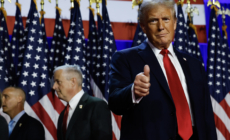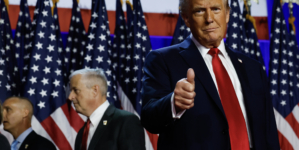-
Hungary’s Viktor Orban and European Far-Right Leaders Welcome Trump’s Return - 25 mins ago
-
Toddler Mom Makes Horror Realization Night Before Family Outing: ‘Forgot’ - 27 mins ago
-
For transgender Americans, Trump’s win is terrifying - 36 mins ago
-
Temple of Satan Seeks Legal Recognition - about 1 hour ago
-
How Democrats Made It Easy for Trump - about 1 hour ago
-
2 weeks after they inherited a home, the Mountain fire happened - about 1 hour ago
-
Were 2024 Election Polls Wrong? Pollsters Give Verdicts - 2 hours ago
-
Opinion | What Is the Best Version of a Second Trump Administration? - 2 hours ago
-
How a graffiti-covered, downtown skyscraper became a viral Halloween costume - 2 hours ago
-
Map Shows Where Harris, Trump Campaign Donations Came From - 2 hours ago
Trump Joins Cleveland in Rare Club of Nonconsecutive US Presidents
Donald Trump’s reelection has brought him into a unique club, joining Democrat Grover Cleveland as one of only two U.S. presidents to serve nonconsecutive terms.
As the 45th president, and now the 47th, Trump follows Cleveland’s path, who held office first in 1885 and then again in 1893. The rare achievement highlights Trump’s sustained influence over a divided electorate.
Before his first presidential win, Cleveland was governor of New York and widely respected for his stability and responsibility, making him an ideal choice for the Democratic nomination in 1884.
His appeal to voters earned him a narrow victory in the popular vote, giving him an edge in the Electoral College that secured his presidency.
Four years later, although he again won the popular vote, Cleveland lost the Electoral College to Republican Benjamin Harrison. However, public regard for him remained high, which paved the way for his successful return in 1892.

Evan Vucci/AP Photo
Advocating Policies That Defined His Party
During his initial term, Cleveland pushed hard to reduce Civil War-era tariffs, making this a hallmark of his administration. His commitment to this policy tied him closely to the Democratic Party’s platform and resonated with the public.
According to historian Daniel Klinghard of Holy Cross College, Cleveland’s advocacy set a precedent for future presidents, who would become vocal leaders for policies closely linked to their parties. “That model of a president being a vocal, clear spokesperson for a policy that animated the party” was emulated by future presidents including Woodrow Wilson, Klinghard said.
Political Influence and Party Dynamics
Cleveland’s allies maintained his presence in the political landscape during his break from office, mobilizing a network of wealthy supporters who favored free trade.
Klinghard notes that this influential group worked actively to keep Cleveland’s name before voters, presenting him as the Democrats’ best option and minimizing other contenders. This approach mirrors strategies Trump’s supporters have used, maintaining his prominence in the party and dismissing potential rivals.
After his presidency, Grover Cleveland served as a trustee of Princeton University, remaining vocal about his political views until he fell gravely ill in 1907. He passed away in 1908.

AP Photo
A Non-Consecutive Presidency Rarely Seen
The unique trajectory shared by Cleveland and Trump illustrates a rare resilience in American politics, where public support can propel a leader back into the White House even after defeat.
With Cleveland as the first to chart this course, Trump’s reelection underscores how voter allegiance, influential support networks, and party alignment can sustain political figures across nonconsecutive terms. As Trump’s unprecedented journey unfolds, it remains to be seen how his administration will affect an already polarized nation.
This article includes additional reporting from The Associated Press
Source link

















